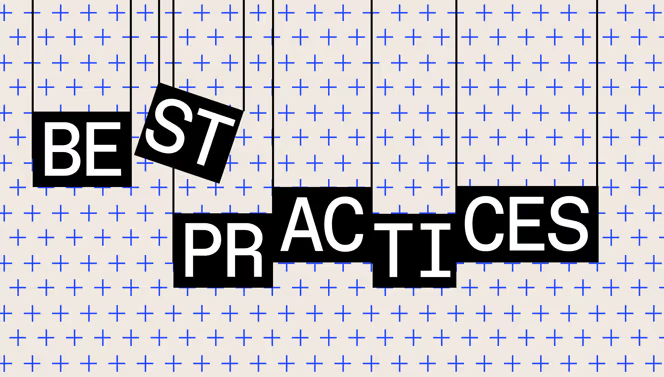The 5 best employee goal-setting frameworks for managers

Discover Workleap Officevibe's benchmark report on 12 key employee engagement metrics

Helping your team members set goals is a key part of driving employee engagement, boosting team performance, and helping your employees reach their full potential. But how to do that can feel like a question mark. What’s the most efficient process for employee goal setting? What’s the best goal-setting framework? How do you monitor employees' progress and ensure they hit their targets?
These simple, straightforward, and researched employee goal-setting frameworks will set you and your employees up for success during the entire process.
What is a goal-setting framework and why should you use it?
A goal-setting framework is a scheme that helps you put in place goals and guides you to reach them successfully. In a professional context, goal-setting frameworks allow employees, managers, and the broader organization to row in the same direction toward common business goals.
Employee goal setting is a must for a number of reasons:
- It improves team alignment. When you work with your employees to set individual goals that feed into your team’s objectives, it gets everyone moving along the same path.
- It creates a vision for the future. A goal-setting framework provides a clear vision of where they’re headed and the autonomy to figure out how to get there boosts employees’ sense of purpose.
- It strengthens employee engagement. Having a career goal to work toward that feels meaningful keeps employees engaged and productive in accomplishing their work.
- It boosts employee retention. When you’re invested in their professional growth, employees have the opportunities and support that keep them around.
The best employee goal-setting frameworks
There's no one-size-fits-all when it comes to goal-setting frameworks. Each of the theories listed below has its benefits and drawbacks, and you may find it useful to use concepts from each in your goal-planning process.
If you're not sure where to start, try the one that speaks the most to you first, and take it from there.
1. OKRs
The objectives and key results goal-setting framework, or OKRs for short, stemmed from Peter Drucker's famous Management by Objectives ideology. In the 1970s, the then-CEO at Intel, Andy Grove, expanded on the concept by adding a key results component to it. The idea was that tying objectives to measurable key performance indicators (KPIs) kept employees accountable for keeping track of and reaching their goals.
{emphasize}
Did you know? OKRs completely transformed Google when the framework was introduced to the company in the late 1990s. With just a dozen employees at the time, setting measurable goals spurred rapid business growth and innovation, and ultimately contributed to Google's world-renown culture.
{emphasize}
OKRs are still all the rage, even 50 years later, because they offer a simple, yet a global way of looking at goal setting. With this framework, it's not just about the end objective, but also about the smaller steps — or measurable and trackable key results — you need to get there.
{emphasize}
How to write OKRs (with an example)
As the name suggests, writing an OKR starts with identifying your primary objective followed by the key results you will use to measure your success.
A simple template to follow is: "I will [objective] as measured by [key result]."
Example: I will improve our product's social proof next quarter, as measured by 8 new client success stories, 5 new testimonials on our website, and a 4+ star rating on G2.
{emphasize}
2. SMART goals
The SMART goal framework was created by George T. Doran in his 1981 paper, "There's a S.M.A.R.T. Way to Write Management's Goals and Objectives." And hasn't evolved much since. The premise of this goal-setting technique lies in its easy-to-remember acronym:
- Specific: What end result are you looking to achieve? Is it specifically defined?
- Measurable: Can you measure the success of this goal with data? How will you measure it?
- Attainable: Is this a realistic goal to set? Do you have what it takes (resources, knowledge, skills, support) to achieve success?
- Relevant: Is this goal aligned with your team and the company's broader objectives? Will it bring relevant value to your organization?
- Timely or time-bound: When do you plan to achieve this goal? Is it the right time to do so?
By answering these questions and ticking off each letter of the SMART goals acronym, employees can easily come up with challenging, yet realistic goals. This makes the process of setting goals less daunting for everyone involved.
{emphasize}
Check out our best SMART employee goal-setting examples if you’re looking for inspiration.
{emphasize}
While this framework offers a great tool for employees to set clear goals, we're starting to see its flaws. For one, SMART goals — no matter how well defined — are sometimes hard to reach. That’s because they focus on the desired end result without offering guidance on how to get there. Can the broader objective be broken down into smaller bite-sized milestones? What does the journey toward the ultimate goal look like? With SMART goals, you may have trouble identifying that.
3. Locke and Latham's 5 principles
Locke and Latham's goal-setting framework took the flaws found in SMART goals and expanded on them. Created by Dr. Edwin Locke and Dr. Gary Latham through years of research, this theory is all about closing the gap between goal setting and goal getting. But how did they do this?
First, Locke and Latham uncovered that difficult or challenging goals make for more productive results. For example, telling someone to aim for a 10% increase in last year's conversion rate is more likely to yield positive results than simply telling them "do your best."
They then went on to identify five key goal-setting elements to consider if you want to boost your chances of achieving your objectives:
- Clarity: This part works hand-in-hand with the SMART framework and is all about setting goals that are clear and direct. Avoiding ambiguity is the first step to reaching success.
- Challenge: It's important to find the right balance between setting a goal that is challenging enough, yet still attainable. Overdo it and you might overwhelm employees; underdo it and you risk losing their motivation.
- Commitment: Getting employees to concretely commit to their goals ensures accountability. And if they have agency in setting their goals, they'll be even more likely to stick to them.
- Feedback: Goals are most effective when you leave room for an iterative process. That's why it's vital to define measurable goals that allow you to keep track of your own progress, and also invite feedback from your trusted peers.
- Task complexity: Overly complex goals often turn into missed goals because they spread employees thin and cause them to feel overwhelmed. To get around task complexity, encourage your team to break goals down into smaller tasks and allot enough time to get the job done.
The overarching theme in this goal-setting framework is that prioritizing motivation and intention leads to better outcomes. And when it comes to setting goals, being able to achieve them is the most important piece to the puzzle.
4. BHAG
BHAG stands for "Big hairy audacious goals" and was coined by Jim Collins and Jerry Porras in their book Built to Last: Successful Habits of Visionary Companies. The amusingly-named framework centers on the idea that every great company must have at least one big, hairy, audacious goal that rallies its people together and gets them excited about what's to come.
{emphasize}
Famous BHAG examples
- President Kennedy committed the United States to "landing a man on the moon and returning him safely to earth."
- Microsoft set the goal of "putting a computer on every desk in every home."
- General Electric set out to "become the #1 or #2 in every market [they] serve and revolutionize [the] company to have the speed and agility of a small enterprise."
{emphasize}
What do all of these examples have in common? They're bold, compelling, and easy to grasp. And if you know these stories well, you know each of these big hairy audacious goals was achieved in due time.
If it's realistic to achieve your goal in a quarter or even a year, you're not thinking big enough. While this framework is great at pushing the company forward, it's less ideal for individual or team goal setting. That's because audacious goals require long timelines and a huge collective effort.
5. Goal pyramid
The goal pyramid is a tiered goals framework and can be looked at in two ways: top-down, focusing on the "why" and bottom-up, focusing on the "how." The main purpose of this method is to take an overarching goal, such as your business's mission, and tie it back to increasingly smaller and digestible steps.
The goal pyramid features these key layers, arranged from broadest to most precise:
- Mission: What is your organization's long-term, overarching objective or raison d'être? What is the end goal of the entire team's collective effort? What global goal are you contributing to day-in-day-out?
- Project: What are the key strategies and projects you need to deliver to bring your team one step closer to its mission? What skills and resources are needed to reach medium milestones? Who do you need to collaborate with to get the job done?
- Task: How can projects be broken down into smaller tasks and initiatives? Who will lead each task and when will they aim to complete them by?
- Subtask: Finally, we arrive at the minutiae. What are the things that need to happen on the daily to make sure you stay on track to achieve your annual, quarterly, and monthly goals?
Approaching the goal pyramid from the top down can also be seen as setting backward goals. In other words, start with your company objectives and build out a solid plan to get there.
Using this framework is a great way to build alignment across your organization as it helps everyone make a clear connection between their individual contributions and the ultimate success of a company.
Best practices to follow when setting goals with employees
Now that we've covered the goal-setting frameworks you can use with your team, we'll cover some best practices to follow so you don't have to start from scratch.
{emphasize}
By following tried and true employee goal-setting tips, you can simplify the process and take some of the load off your shoulders. These tips will save you time and keep your goal-setting strategy consistent across the board.
{emphasize}
Get clear on your team and organizational goals
You can’t tie individual employee goals to the overarching goal if you don’t know what that bigger picture is. That’s why, before you meet with your employee and jump into the individual goal-setting process, it’s important to get clear on your broad objectives. That means understanding your team goals and the business objectives they feed into.
{emphasize}
Goal-setting questions for managers:
- What are the goals my team is working towards?
- What business goal is our organization as a whole working towards?
- How does this individual team member’s role and responsibilities fit into those team and organizational goals?
{emphasize}
Being clear on where your team is headed from the get-go helps you set employee goals that both help them get to where they want to go and help your team reach their desired destination.
{emphasize}
🎯 Learn how to define realistic objectives that align with company strategy and your employees’ strengths with our complete goal-setting guide.
{emphasize}
Get to know your employee’s strengths
For goal setting to be effective, the goals you set with your employees need to play to each individual employee’s strengths. So, part of the process is sitting down with your people and getting to know who they are and where they excel.
Schedule a one-on-one meeting and have a conversation with your employee about their role within the team, their skill set (both hard and soft skills), and the areas they’re excited to explore and develop.
{emphasize}
Pro-tip: To make the most out of your sit down, ask your team members to prepare for your meeting by doing a self-reflection on their strengths. Set this as a talking point in your goal-setting meeting agenda.
{emphasize}
{emphasize}
Employee goal-setting questions:
- What motivates you the most at work?
- How have you contributed to reaching the team’s objectives?
- How would you like to use your strengths in the future?
- Who do you want to be in 5 years?
{emphasize}
Talking through your employee’s self-reflection exercise can help you gain a deeper understanding of how they view their work and their contributions to the team. And this will be a major help during the goal-setting process.
Collaborate with your employees to set goals
Once you’ve wrapped your head around your employees’ strengths, it’s time to jump into setting goals. Keep the number of goals you set manageable, and aim for no more than three goals. You also want to find a balance between goals that are directly related to team objectives (performance goals) and those geared more toward developing their expertise (development goals).
Once you and your employee have settled on the right goals to pursue, have a conversation about what they’ll need to achieve them. This could mean specific tools, resources, or support from their peers or leadership team. Create an action plan and delegate tasks to get them started and set them up for success.
Coach your employee along the way
Now your employee has goals they’re working towards. And as a manager, your goal should be to help them achieve their goals. That means you’ll need to provide support and coaching along the way. How you coach and support your employee in reaching their set goal will depend on the employee and the goal, but it’s important to make sure they feel supported.
{emphasize}
For example, if your employee’s goal is to close a big client, offer to sit in on their next product demo or practice pitch and give them notes on how they can improve and close more sales. If their goal is to land a big promotion, schedule a meeting to give them more insights on the role and what they need to do to get there.
{emphasize}
The more you coach and support your employee as they work towards their goal, the more likely it is they’ll hit that key result. And that’s when the employee goal-setting exercise becomes a success — both for them and for your team.
Schedule regular one-on-one meetings to track goal progress
You want to stay on top of how your employee is doing, how they’re progressing toward their goals, and whether those goals need to be tweaked, changed, or adjusted. Schedule regular one-on-one meetings to help set smaller action items toward employee goals and track their progress.
{emphasize}
Questions to monitor employee goal progress:
- As things stand, do you think you will be able to achieve your goal? Why?
- Do you need my help identifying which actions could help you achieve your goals?
- Do you need to have a clearer picture of how your individual goals allow us to attain our goals as a team or a company?
- Do you sometimes feel bored or unchallenged at work? If so, would you like your goals to be revised so that they’re more challenging?
{emphasize}
What to do if goals aren’t met
Even when employees have clear goals and are motivated to hit them, they may encounter challenges that prevent them from hitting the mark. This can be a disappointing experience — both for them as an employee and for you as a manager.
The best thing to do in this situation is to get to the root of what went wrong. That way, you can both learn from the experience, and figure out the best way to move forward.
{emphasize}
Questions to ask when goals aren’t met:
- Was there a problem with the goal itself (timeframe, specificity, etc.)?
- Was there something you were missing to achieve your goal (resource, tool, support)?
- Is there anything that I could have helped with or that I should know?
- Is the goal still relevant and attainable if we alter the scope/timeline?
- How do you see us proceeding forward from here?
{emphasize}
sking open-ended one-on-one questions will create a safe, non-judgmental space for employees to share what prevented them from hitting their goal — and things you as a manager may have missed. Once you’ve had a conversation about what didn’t work, you can work together to figure out what might work better, and create a plan for how to move forward.
Use goal setting to empower your employees
When employees work towards the right goals, it drives engagement and performance. And there’s no need to stress over the goal-planning process when you follow a clear and straightforward framework.
If you want to go the extra mile, you can't go wrong with using a goal-setting sidekick like Officevibe. Its dedicated goals and OKRs tool helps you set, track, and centralize goals with each team member, so you can aim for success month over month and year over year.
FAQs
What’s the best HR platform for aligning individual goals with company strategy?
The best platforms for alignment make it easy to connect employee goals directly to team and organizational objectives. Workleap Performance supports this by using OKRs, shared goal visibility, and progress tracking that helps employees see how their work ladders up.For more on building meaningful alignment, this podcast offers helpful perspective
Which software helps managers align goals to company strategy?
Workleap Performance gives managers a clear and structured way to align employee goals with broader company objectives. The platform makes it easy to set meaningful goals, track progress through OKRs, and connect day-to-day work to strategic priorities. It also supports managers with built-in coaching tools, real-time feedback, and guidance that helps them empower their teams more effectively.To better understand why manager empowerment is essential for driving alignment and engagement, you can watch this webinar on leading with impact and boosting manager effectiveness
Which HR platform integrates goal tracking and performance management with collaboration tools like Microsoft Teams?
Workleap Performance offers goal tracking and performance tools that work smoothly alongside collaboration platforms like Microsoft Teams. This helps managers keep goals visible, align expectations, and make performance conversations part of everyday work.
Give HR and managers the clarity, confidence, and connection to lead better every day.


%20(1).avif)


.avif)
.avif)








